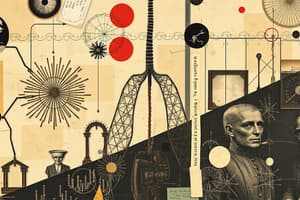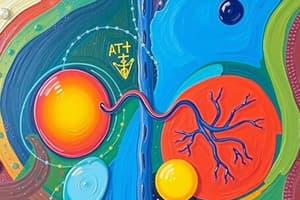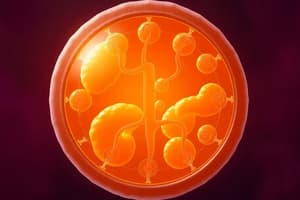Podcast
Questions and Answers
What is the primary role of FAD+ in cellular respiration?
What is the primary role of FAD+ in cellular respiration?
- To donate electrons to the electron transport chain.
- To directly convert glucose into pyruvate.
- To provide energy for the input stage of glycolysis.
- To accept electrons and become reduced to FADH2. (correct)
Which of the following best describes the overall nature of cellular respiration?
Which of the following best describes the overall nature of cellular respiration?
- Endergonic and catabolic.
- Endergonic and anabolic.
- Exergonic and anabolic.
- Exergonic and catabolic. (correct)
Where does the Krebs cycle take place?
Where does the Krebs cycle take place?
- Across the inner membrane of the mitochondria.
- In the cytoplasm.
- In the matrix of the mitochondria. (correct)
- In the intermembrane space of the mitochondria.
What is the net gain of ATP molecules in glycolysis?
What is the net gain of ATP molecules in glycolysis?
What is the final product of glycolysis?
What is the final product of glycolysis?
What is the primary function of ATP synthase in the context of cellular respiration?
What is the primary function of ATP synthase in the context of cellular respiration?
Which process does NOT utilize ATP synthase to produce ATP?
Which process does NOT utilize ATP synthase to produce ATP?
What signifies a molecule is being oxidized in a redox reaction?
What signifies a molecule is being oxidized in a redox reaction?
In cellular respiration, which molecule serves as the final electron acceptor?
In cellular respiration, which molecule serves as the final electron acceptor?
Which of the following best describes substrate-level phosphorylation?
Which of the following best describes substrate-level phosphorylation?
What products are produced in cellular respiration, besides ATP?
What products are produced in cellular respiration, besides ATP?
What happens to the electrons stripped from glucose during cellular respiration?
What happens to the electrons stripped from glucose during cellular respiration?
What do NAD+ molecules become when they accept electrons from glucose?
What do NAD+ molecules become when they accept electrons from glucose?
In cellular respiration, what is the primary role of mitochondria?
In cellular respiration, what is the primary role of mitochondria?
What is the main function of the phospholipid bilayer in the cell membrane?
What is the main function of the phospholipid bilayer in the cell membrane?
Which of the following best describes the process of catabolism?
Which of the following best describes the process of catabolism?
What is the function of the enzyme ATPase regarding ATP?
What is the function of the enzyme ATPase regarding ATP?
What is the primary fate of pyruvate in the absence of oxygen in human muscle cells?
What is the primary fate of pyruvate in the absence of oxygen in human muscle cells?
Which of the following statements describes the structure of a mitochondrion?
Which of the following statements describes the structure of a mitochondrion?
How many net ATP molecules are produced from glycolysis in the absence of oxygen?
How many net ATP molecules are produced from glycolysis in the absence of oxygen?
Why is the bond between the last two phosphates in ATP considered a high-energy bond?
Why is the bond between the last two phosphates in ATP considered a high-energy bond?
Which of the following best describes the role of the electron transport chain (ETC)?
Which of the following best describes the role of the electron transport chain (ETC)?
What is the purpose of the hydrophobic fatty acid tails in the cell membrane's phospholipid bilayer?
What is the purpose of the hydrophobic fatty acid tails in the cell membrane's phospholipid bilayer?
Which of the following molecules is embedded within the plasma membrane, playing a role in selective transportation?
Which of the following molecules is embedded within the plasma membrane, playing a role in selective transportation?
How many molecules of NADH are produced per glucose molecule during the Krebs cycle?
How many molecules of NADH are produced per glucose molecule during the Krebs cycle?
During aerobic cellular respiration, what is the direct product of pyruvate oxidation before it enters the Krebs cycle?
During aerobic cellular respiration, what is the direct product of pyruvate oxidation before it enters the Krebs cycle?
What is the total number of ATP molecules produced in the Krebs cycle per glucose molecule?
What is the total number of ATP molecules produced in the Krebs cycle per glucose molecule?
What molecule is produced during fermentation in yeast cells?
What molecule is produced during fermentation in yeast cells?
In which location of the mitochondria does the Krebs cycle take place?
In which location of the mitochondria does the Krebs cycle take place?
How does cyanide primarily disrupt cellular respiration?
How does cyanide primarily disrupt cellular respiration?
What is a common source of cyanide exposure that may occur in a typical household fire?
What is a common source of cyanide exposure that may occur in a typical household fire?
Why are some mutations in the electron transport chain considered particularly damaging?
Why are some mutations in the electron transport chain considered particularly damaging?
If a substance, such as rotenone blocks the electron transport chain, what is the most immediate effect on the cell?
If a substance, such as rotenone blocks the electron transport chain, what is the most immediate effect on the cell?
Why are domestic sweet almonds considered safe for consumption, while wild bitter almonds can be dangerous?
Why are domestic sweet almonds considered safe for consumption, while wild bitter almonds can be dangerous?
During the electron transport chain, what is the primary role of hydrogen ions (H+)?
During the electron transport chain, what is the primary role of hydrogen ions (H+)?
How many hydrogen ions (H+) are pumped into the intermembrane space for each NADH molecule during the electron transport chain?
How many hydrogen ions (H+) are pumped into the intermembrane space for each NADH molecule during the electron transport chain?
What is the role of the transmembrane potential created in the mitochondria?
What is the role of the transmembrane potential created in the mitochondria?
How many ATP molecules are generated by ATP synthase for every 4 hydrogen ions (H+) that flow through it?
How many ATP molecules are generated by ATP synthase for every 4 hydrogen ions (H+) that flow through it?
Approximately, how many ATP molecules are produced from one NADH molecule that goes through the electron transport chain?
Approximately, how many ATP molecules are produced from one NADH molecule that goes through the electron transport chain?
How many ATP molecules are produced from one FADH2 molecule that goes through the electron transport chain?
How many ATP molecules are produced from one FADH2 molecule that goes through the electron transport chain?
What is the electrochemical gradient, that is created by the electron transport chain, also known as?
What is the electrochemical gradient, that is created by the electron transport chain, also known as?
What is the approximate total number of ATP produced per glucose molecule, including glycolysis, Krebs cycle and the electron transport chain?
What is the approximate total number of ATP produced per glucose molecule, including glycolysis, Krebs cycle and the electron transport chain?
Flashcards
Cellular Respiration
Cellular Respiration
The process where cells break down glucose to produce energy in the form of ATP.
Cell Membrane
Cell Membrane
A double layer of phospholipids that forms the outer boundary of a cell, controlling what enters and exits.
Selective Permeability
Selective Permeability
The ability of the cell membrane to allow certain substances to pass through while blocking others.
Passive Transport
Passive Transport
Signup and view all the flashcards
Active Transport
Active Transport
Signup and view all the flashcards
Osmosis
Osmosis
Signup and view all the flashcards
Resting Membrane Potential
Resting Membrane Potential
Signup and view all the flashcards
Mitochondrion
Mitochondrion
Signup and view all the flashcards
Glycolysis
Glycolysis
Signup and view all the flashcards
Krebs Cycle
Krebs Cycle
Signup and view all the flashcards
Electron Transport Chain
Electron Transport Chain
Signup and view all the flashcards
FAD+
FAD+
Signup and view all the flashcards
Fermentation
Fermentation
Signup and view all the flashcards
Acetyl CoA
Acetyl CoA
Signup and view all the flashcards
Electron Transport Chain (ETC)
Electron Transport Chain (ETC)
Signup and view all the flashcards
ATP (Adenosine Triphosphate)
ATP (Adenosine Triphosphate)
Signup and view all the flashcards
Role of NADH and FADH2
Role of NADH and FADH2
Signup and view all the flashcards
What is the Electron Transport Chain (ETC)?
What is the Electron Transport Chain (ETC)?
Signup and view all the flashcards
How do genetic mutations affect the Electron Transport Chain?
How do genetic mutations affect the Electron Transport Chain?
Signup and view all the flashcards
What are ETC poisons and how do they work?
What are ETC poisons and how do they work?
Signup and view all the flashcards
What is cyanide and how does it affect the ETC?
What is cyanide and how does it affect the ETC?
Signup and view all the flashcards
What are some common ETC poisons?
What are some common ETC poisons?
Signup and view all the flashcards
What are NADH and FADH2?
What are NADH and FADH2?
Signup and view all the flashcards
How does the ETC create a proton gradient?
How does the ETC create a proton gradient?
Signup and view all the flashcards
What is transmembrane potential?
What is transmembrane potential?
Signup and view all the flashcards
What is ATP Synthase?
What is ATP Synthase?
Signup and view all the flashcards
How does ATP synthase produce ATP?
How does ATP synthase produce ATP?
Signup and view all the flashcards
How much ATP is produced per glucose?
How much ATP is produced per glucose?
Signup and view all the flashcards
Why is the ETC important?
Why is the ETC important?
Signup and view all the flashcards
Substrate-Level Phosphorylation
Substrate-Level Phosphorylation
Signup and view all the flashcards
Oxidative Phosphorylation
Oxidative Phosphorylation
Signup and view all the flashcards
Aerobic Respiration
Aerobic Respiration
Signup and view all the flashcards
Anaerobic Respiration
Anaerobic Respiration
Signup and view all the flashcards
Oxidation
Oxidation
Signup and view all the flashcards
Reduction
Reduction
Signup and view all the flashcards
Electron Carrier
Electron Carrier
Signup and view all the flashcards
Final Electron Acceptor
Final Electron Acceptor
Signup and view all the flashcards
Study Notes
Cellular Level of Organization
- The cellular level is the fundamental level of organization in living organisms.
- Objectives for study of cellular organization include outlining cellular respiration, describing the cell membrane and its functions, explaining cellular transport types, describing osmosis and solutions' effects on cells, and describing the factors contributing to resting membrane potential.
Cell Membrane
- The cell membrane is selectively permeable, regulating what enters and exits the cell.
- The membrane's structure consists of a phospholipid bilayer with embedded proteins and cholesterol molecules.
- Glycoproteins are present on the extracellular side of the membrane.
- Hydrophobic fatty acid tails are on the inside of the membrane, and hydrophilic phosphate heads are on the outside.
Cellular Respiration and Mitochondria
- Mitochondria are called the "powerhouse" of the cell.
- They use glucose to produce energy in the form of ATP.
- Mitochondria have an outer membrane and an inner membrane with folds called cristae.
- The intermembrane space is between the outer and inner membranes, and the inner matrix folds around cristae.
Metabolism Review
- Metabolism is the sum of all chemical reactions in a living organism.
- Anabolism refers to building up molecules, which requires energy.
- Catabolism refers to breaking down molecules, releasing energy.
ATP Structure and Function
- ATP (adenosine triphosphate) is a crucial energy molecule.
- Its structure includes an adenine base, a ribose sugar, and three phosphate groups.
- Energy is released when the terminal phosphate bond is broken (dephosphorylation).
ATP Review: Dephosphorylation and Hydrolysis
- Dephosphorylation is the process of breaking the high-energy phosphate bond in ATP to release energy.
- ATP hydrolysis involves adding water to the ATP molecule, separating the phosphate groups and releasing energy.
- ATPase is an enzyme that catalyzes this reaction.
ATP Re-making: Phosphorylation
- Phosphorylation is the re-making of ATP.
- It's the reverse process of dephophorylation.
- ATP synthase is the enzyme that re-makes ATP during cellular respiration.
Two Types of Phosphorylation
- Substrate-level Phosphorylation — a phosphate group is directly transferred from a substrate molecule to ADP in reactions, and it does not involve ATP synthase.
- Oxidative Phosphorylation — phosphate addition that uses energy from the electron transport chain and involves ATP synthase.
Aerobic and Anaerobic Respiration
- Aerobic respiration requires oxygen and produces a large amount of ATP from glucose (36-38).
- Anaerobic respiration does not require oxygen and produces less ATP from glucose (2).
- Anaerobic respiration produces lactic acid in animals.
Overall Equation for Cellular Respiration
- The overall equation for cellular respiration is C6H12O6 + 6O2 → 6CO2 + 6H2O + energy (ATP).
- Glucose reacts with oxygen to produce carbon dioxide, water, and energy.
Cellular Respiration as a REDOX Reaction
- Cellular respiration involves oxidation and reduction reactions (Redox reactions).
- Glucose is oxidized (loses electrons) and oxygen is reduced (gains electrons).
- Oxygen is the final electron acceptor which produces water
Electron Carriers
- NAD+ and FAD+ are electron carriers that pick up electrons from glucose.
- They are reduced to NADH and FADH2, storing and delivering those electrons to the electron transport chain.
Stages of Cellular Respiration
- Glycolysis is the first stage, breaking down glucose.
- The Krebs Cycle is an intermediate stage, producing ATP and transferring electrons.
- The Electron Transport Chain (ETC) is the final stage, using electrons to generate a large amount of ATP.
Key Points of Glycolysis
- Glycolysis occurs in the cytoplasm and is an anaerobic process.
- Glycolysis starts with one molecule of glucose (6 carbons) and produces 2 molecules of pyruvate (3 carbons each).
- 2 ATP are used in the process, while 4 ATP molecules are produced, giving a net gain of 2 ATP molecules
- 2 NADH molecules are produced in the process.
Pyruvate Fate after Glycolysis
- If oxygen is present, pyruvate enters the mitochondria as acetyl CoA and undergoes further oxidation in the Krebs Cycle.
- If oxygen is absent, fermentation (lactic acid or alcoholic) happens.
Fermentation
- Fermentation is an anaerobic process that creates lactic acid or alcohol, depending on the organism.
- Fermentation happens when insufficient oxygen.
Krebs Cycle Summary
- The Krebs cycle occurs in the mitochondrial matrix in an aerobic environment.
- Two turns are needed for each glucose molecule.
- Pyruvate (from glycolysis) is used as input.
- The output is 2 ATP, 6NADH, and 2 FADH2, and 6CO2 per glucose molecule
Electron Transport Chain (ETC)
- The ETC occurs on the inner mitochondrial membrane.
- It uses electron carriers (NADH and FADH2) to create a proton gradient.
- This gradient drives ATP synthesis via ATP synthase.
Transmembrane Potential
- Transmembrane potential is the difference in charge across a membrane.
- It results from a concentration gradient of protons (H+).
ATP Synthase
- The ATP synthase is an enzyme that is involved in phosphorylation.
- It generates ATP from ADP and an inorganic phosphate which uses the energy stored in the electrochemical gradient of protons (H+).
How H+ Translates to ATP
- 4 H+ ions are required for one molecule of ATP to be made.
- Pumped across the membrane using ATP Synthase energy
- 10 H+ from NADH lead to 2.5 ATP
- 6 H+ from FADH2 lead to 1.5 ATP.
Cellular Respiration Summary
- The overall outcome of cellular respiration is a variable yield of ~30–38 ATP molecules per glucose molecule.
- ATP production depends on the cell type and specific enzymes.
Helpful Videos
- Crash Course on Cellular Respiration and various other videos are listed as useful resources for further learning or additional explanations on the subject.
Genetic Mutations Affecting Protein Structure
- Some diseases arise from mutations impacting essential proteins in the electron transport chain.
- Many genetic disorders are maternally inherited.
ETC Poisons
- Certain substances block the electron transport chain, inhibiting ATP production.
- Some examples of ETC poisons are rotenone, cyanide, and oligomycin.
Cyanide Poisoning
- Smoke inhalation is a typical cause of cyanide poisoning, as certain materials release cyanide when combusted.
- Symptoms such as immediate headaches, nausea, and dizziness can develop quickly, followed by respiratory failure and coma in serious cases.
- Treatment includes removing the source of cyanide exposure and seeking immediate medical care.
Studying That Suits You
Use AI to generate personalized quizzes and flashcards to suit your learning preferences.




